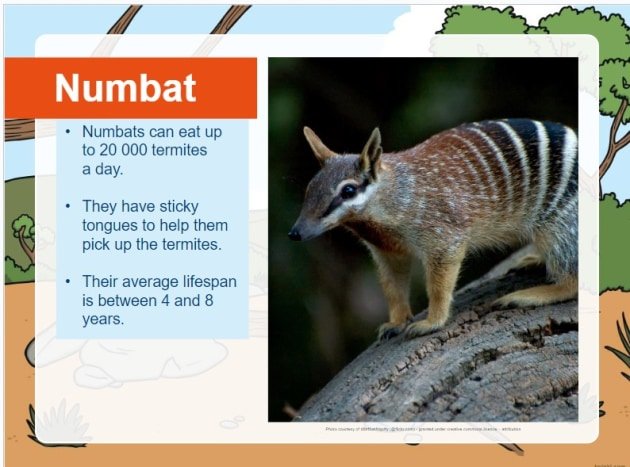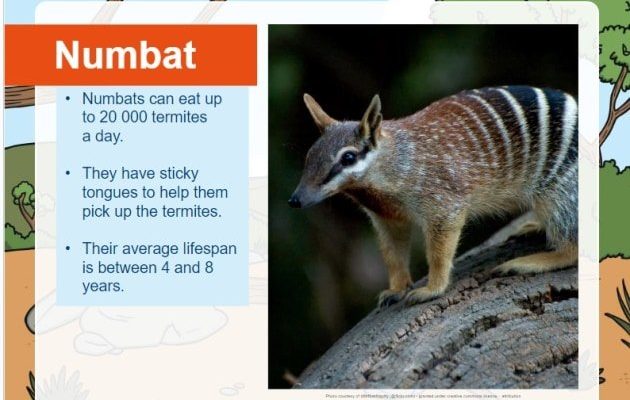
You might be surprised to learn that numbats aren’t found just anywhere; they have specific habitat preferences that make them truly special. They thrive in certain types of forests and wooded areas, and their distribution has changed over time. If you’re curious about how these adorable little creatures have adapted to their environment, keep reading. We’ll explore their habitat, distribution, and the challenges they face in the wild.
Numbat Habitat Basics
Numbats primarily live in dry sclerophyll forests and woodlands located in southwestern Australia. These areas are characterized by a mix of eucalyptus trees, shrubs, and open grasslands. Numbats love habitats that offer plenty of termite mounds, their primary food source. Imagine walking through a sun-dappled forest where the air is filled with the sounds of birds and rustling leaves; this is a numbat’s paradise.
These little critters have specific preferences when it comes to their living conditions. They enjoy areas with open canopies that allow sunlight to filter through. This light not only helps create a warm environment for them but also supports the growth of the low vegetation they hide in. Without the right trees and underbrush, numbats would struggle to survive.
The numbat is quite the specialist when it comes to its habitat. Unlike some animals that can easily adapt to different environments, numbats rely heavily on the presence of termites. Due to this reliance, any changes in their habitat can have significant effects on their population. So, let’s look a bit deeper into where you can find these cute marsupials.
Where Are Numbats Found? Distribution Overview
Originally, numbats used to roam across a much larger area of southwestern Australia. However, their distribution has shrunk significantly over the years. Today, they’re mainly found in a few protected areas, particularly in Western Australia. The largest populations can be spotted in places like Warren National Park and Dryandra Woodland.
The decline in numbat populations is primarily due to habitat loss and the introduction of predators like foxes and cats. These factors have pushed numbats into smaller pockets of their original range. It’s like being pushed into a corner; the available space keeps getting smaller, making life much tougher for these adorable creatures.
Despite the challenges they face, conservation efforts are underway. Various organizations are working to protect their habitats and reintroduce them into areas where they’ve disappeared. This gives hope to the future of numbats in Australia.
Environmental Factors Influencing Numbat Habitats
Numbats are sensitive to environmental changes, which is why habitat quality is crucial for their survival. They prefer areas that maintain a stable climate, including moderate temperatures and adequate rainfall. These conditions help sustain the termite populations that numbats rely on. Think of it this way: if you love ice cream, you need to have a shop nearby, right? For numbats, their “ice cream” is termites, and they need the right environment to keep enjoying them.
Moreover, soil quality also plays a role in habitat suitability. Numbats tend to thrive in sandy soils that support the growth of specific plants. These plants are essential not just for cover but also for maintaining the overall ecosystem that supports termites. The interconnectedness of the food web shows just how important it is to preserve these environments.
Human activity has a significant impact on these habitats. Urban development, agriculture, and land clearing can alter the landscape, making it less hospitable for numbats. Protecting the right areas is key to ensuring that these unique marsupials continue to thrive.
The Importance of Termites in Numbat Habitats
You can’t talk about numbats without mentioning their favorite snack: termites. These little insects are vital to a numbat’s diet and play a crucial role in their habitat. Numbats can consume over 20,000 termites in a single day! That’s like eating multiple plates of your favorite dish all at once. This high-energy diet is necessary for their active lifestyle.
The presence of termites is a strong indicator of a healthy habitat. When the soil is undisturbed, it allows termites to thrive, which in turn supports not just numbats but many other species within the ecosystem. The relationship between numbats and their food source is a delicate balance. If termite populations decline, numbats face serious challenges.
Interestingly, numbats have evolved to have long, sticky tongues that can reach deep into termite mounds. This specialization is a great example of adaptation in action. It’s almost like having the perfect tool for a job; their tongue is designed to be effective in extracting termites from narrow spaces.
Conservation Efforts and Challenges
If you’re feeling concerned about the future of numbats, you’re not alone. Conservationists are actively working to protect these unique creatures. Various programs aim to restore their natural habitats and reintroduce numbats to areas where they’ve been wiped out. It’s like giving them a second chance at life!
Captive breeding programs have also been established, helping to increase numbers. These programs work to produce young numbats in controlled environments, which are then released into protected areas. Picture this: volunteers and scientists carefully raising baby numbats, preparing them for their wild adventures.
However, the journey isn’t entirely smooth. There are still numerous challenges to face, including habitat fragmentation and the ongoing threat from predators. It’s essential to create wildlife corridors—safe pathways that allow numbats to move between different areas—so they can thrive and mingle with other populations.
The Future of Numbats and Their Habitat
As we look to the future, the survival of numbats depends heavily on continued conservation efforts. Protecting their habitats from development and predators is crucial. Think of it like maintaining a garden; if you let weeds take over, your beautiful flowers struggle to grow. In the case of numbats, the “weeds” are threats to their habitats.
Public awareness and education play significant roles in conservation. When people understand the importance of species like the numbat, they’re more likely to support protective measures. Simple actions, like being mindful of wildlife when enjoying nature, can help tremendously.
As we learn more about numbats and their habitats, it’s vital to foster a sense of responsibility toward protecting these unique creatures and the ecosystems they inhabit. After all, every little bit helps when it comes to preserving the rich biodiversity that makes Australia so special.
In sum, numbats are unique marsupials with specific habitat needs that reflect the delicate balance of their environment. By understanding where they live and the challenges they face, we can all contribute to ensuring their survival for generations to come. So, the next time you hear about numbats, you’ll know just how special they are and why it’s so important to protect their home.

